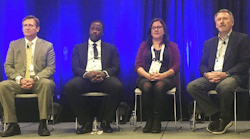(Caption, left to right: Scott Adams, Eaton; Kareem Maine, Ultium Cells; Heather Soerries, Cirba Solutions; Steven Sumner, Lincoln Electric)
Lots of excitement and lots of challenges in the fast-moving electric vehicle industry and both descriptions quickly work their way into the conversation. Such was the case this week at the Safety Leadership Conference in Cleveland, which featured a keynote panel discussion on the future of electric vehicles and EHS considerations. The keynote was a joint presentation with IndustryWeek's Manufacturing & Technology Show.
Panelists from Cirba Solutions, Eaton, Lincoln Electric and Ultium Cells discussed their participation in the EV industry and tackled topics ranging from talent development, safety and sustainability to how quickly the electric vehicle market will develop.
Here are highlights from the wide-ranging discussion:
Safety as a Top Priority
You’ve likely heard of Ultium Cells if you follow progress in the EV industry to any degree. Ultium Cells is a joint venture between General Motors and LG Energy Solution to manufacture battery cells, and its site near Youngstown, Ohio, is the first of three in the works. The Ohio facility, which represents a $2.3 billion investment, is the only one producing product currently and it’s so new that only about 20% of its equipment is installed.
Ultium Cells panelist Kareem Maine is nearly as new—at least to the Ultium plant. Maine is plant director at the Ohio site, having moved over from a General Motors stamping plant in August. Among the goals of the joint venture is to blend the cultures of GM and LG “and create one Ultium culture,” he says.
Maine discussed the transition from working in vehicle propulsion and metal stamping environments to Ultium, where chemical manufacturing processes are prevalent. What is similar between the manufacturing types is the focus on safety as a top priority, he said, although what constitutes the top safety issue is unique to every plant. “We’re in a plant that has chemicals now, so we’re trying to benchmark the best of the best to see what practices we can bring inside the building,” he says.
The Push into the Electric Vehicle Space
You might think of the EV industry as the birthplace of startups, but manufacturers Eaton and Lincoln Electric, both of which are more than 100 years old, are significant players. Eaton formed its eMobility division in 2018, although the manufacturer had been participating a bit in the electric space before then. “But it was kind of haphazard,” explained Scott Adams, president of the eMobility division. The market had seen “fits and spurts of electrification” in vehicles over many years, only for those opportunities to dry up, Adams said.
More recently, however, the drivers of electrification seemed more “real,” Adams said. Those drivers now included CO2 emissions as well as fuel economy, coupled with China’s push to develop new energy vehicles.
“It took us about a year to convince our senior leadership because of the history,” he said.
Like Eaton, Lincoln Electric already played a role in the EV industry, but the welding company was always on the lookout for opportunities to grow. “If you think about our company as a power conversion company, it happens to be a welder today, but it could be anything,” said Steven Sumner, vice president, Global Equipment, at Lincoln Electric. “So we said, ‘Let’s build an EV charging business.”
On Challenges
One big challenge to the EV industry is the shortage of lithium, pointed out Heather Soerries, QEHS specialist at Cirba Solutions. “We don’t have the lithium available right now to meet the need into 2030.”
Cirba Solutions dismantles and recycles EV batteries, doing its part to keep them out of landfills. “Sustainability is a major part of our company.”
In addition to recycling, the EV panelists raised the topics of reusing and repurposing EV batteries. Eaton’s Adams said his company has worked with Nissan to repurpose batteries for uninterruptible power supply systems, and he pointed to a sports arena project in Amsterdam. It used a blend of new batteries and repurposed batteries. Additionally, Sumner referenced a discussion by the Center for Automotive Research in which the energy in used EV batteries could be harnessed and returned to the grid, perhaps to assist during peak demand.
Sumner is very clear on where several challenges for the industry lie. On the charging side of the equation, it’s interoperability. “Thirty percent of all charging events today fail, because the car and the charger won't talk to each other, despite the fact that there is an industry standard.” It’s a bigger problem than most people realize, he believes.
He also pointed to the $5 billion allocated by the Infrastructure Investment and Jobs Act to build a nationwide network of EV charging stations over five years. Sumner outlined a scenario that would place charging stations approximately every 50 miles along this alternative fuel corridor.
Dave Blanchard contributed to this article.
